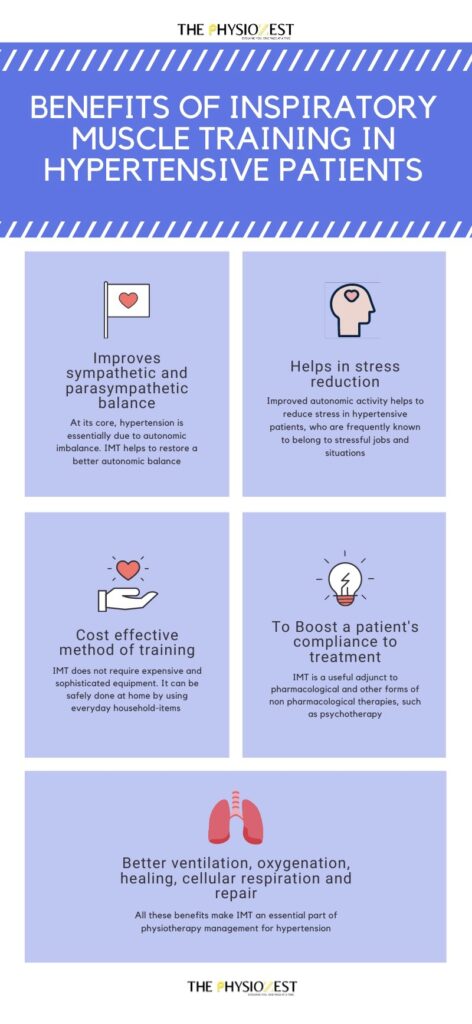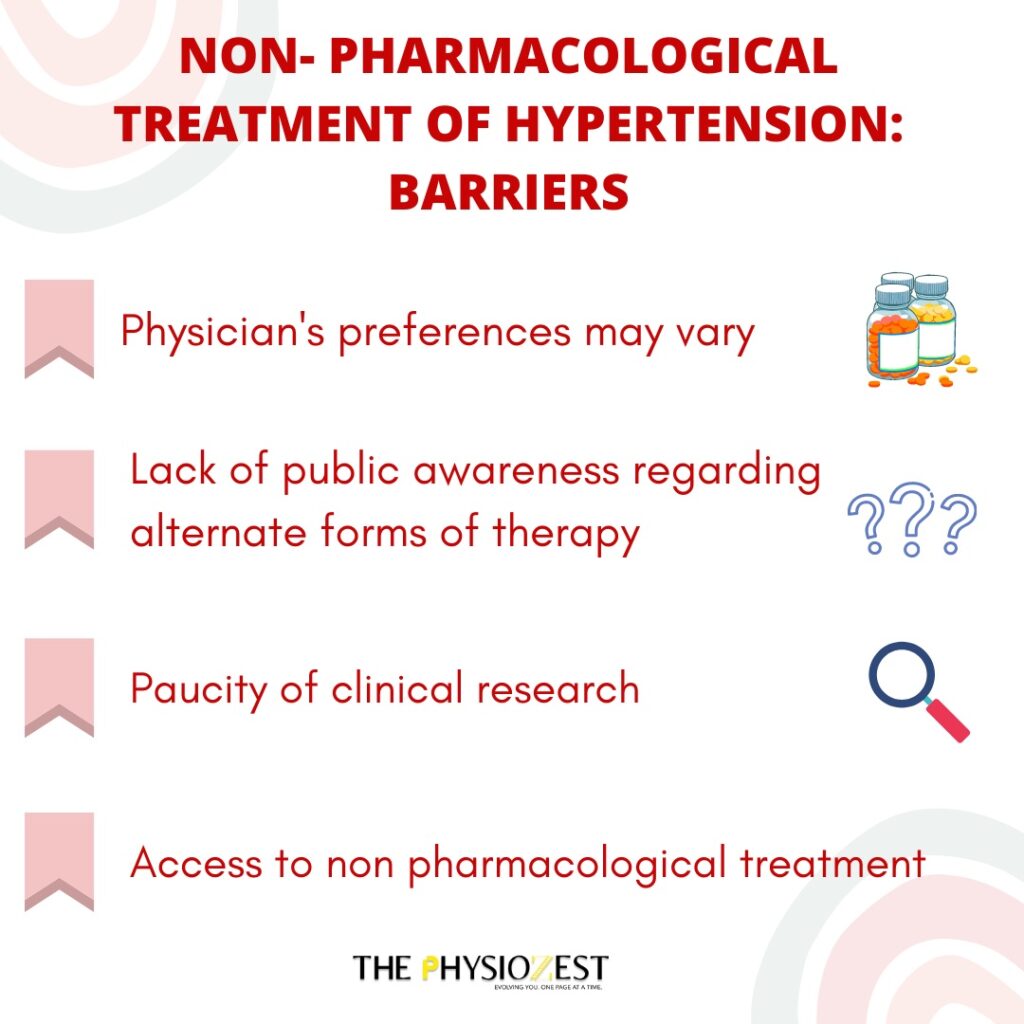Can Breathing well control Blood Pressure?
Effect of inspiratory muscle training on hypertension and sympathetic activity
Review by Dr. Juwariyah Dalvi
Graphics by Divya Sharma
Share this article
Paper review of – “Inspiratory muscle training reduces blood pressure and sympathetic activity in hypertensive patients: A randomized controlled trial”, Janaína Barcellos Ferreira, Rodrigo Della Méa Plentz, Cinara Stein, Karina Rabello Casali, Ross Arena, Pedro Dal Lago, International Journal of Cardiology, Volume 166, Issue 1, 2013, Pages 61-67, ISSN 0167-5273, https://doi.org/10.1016/j.ijcard.2011.09.069.
Key points
- Effect of inspiratory muscle training on blood pressure
- Reduction in blood pressure and increased parasympathetic modulation
- Increased inspiratory muscle strength
- Non-pharmacological management of hypertension
- Adjunctive tool for rehab in sedentary patients and those who cannot be prescribed strenuous exercise
Abstract
The aim of this study was to find out the effects of Inspiratory Muscle Training (IMT) on blood pressure to explore a non-pharmacological treatment aspect in the treatment of hypertension. The premise of this study was the relation of sympathetic activity and autonomic imbalance in hypertensive patients. 13 patients with hypertension were assigned to IMT and Placebo group randomly for an 8-week protocol with the IMT group receiving 30% inspiratory muscle loading whereas the placebo group received no loading. It was found that there was a significant increase in inspiratory muscle strength in the IMT group but not in the placebo group. The IMT group also showed a reduction in 24-hour blood pressure as well as daytime blood pressure — both systolic and diastolic, increased parasympathetic modulation, decreased sympathetic modulation, and reduction in cardiac sympathetic discharge. Thus it was concluded that IMT is an effective non-pharmacological method to control systolic and diastolic blood pressure and ensure good autonomic cardiovascular control in hypertensive patients.
Introduction
The most common advice we give to our hypertensive patients is to reduce their stress. The lifestyle we are all living constantly succumbs us to activate our flight-fright mechanisms. However, the literature is deficient in the implications of mechanisms that reduce stress without pharmacological intervention or psychotherapy. This study explores the potential of IMT, a simple clinical method that mediates with the autonomic system and reduces sympathetic activity in hypertensive patients. IMT is also a simple non-pharmacological method to lower blood pressure and improve inspiratory muscle strength, which has various other systemic benefits (better ventilation, oxygenation and perfusion, cellular respiration, infection prevention, effective healing, and repair).

The Study Design
Strong Clinical Implications
Even though the autonomic mechanisms are not entirely defined, the outcomes in the form of inspiratory muscle strength, hypertension management, and reduction of cardiac sympathetic discharge have turned out to be significant and are very clinically relevant.
IMT is a boon in dealing with:
•Patients suffering from hypertension generally belonging to high demanding stressful jobs and practicing a sedentary lifestyle[2]
•Lack of awareness and hesitancy in seeking psychotherapy for stress management
•Consensus in the medical fraternity to promote non-pharmacological management of hypertension
•Link of obesity with hypertension and sedentary lifestyle and avoidance of various exercise regimes to prevent undesirable joint loading
•Difficulty in rehabilitating elderly hypertensive patients due to various contra-indications to exercise due to additional co-morbidities and difficulty in adapting to lifestyle changes
•Patients with other comorbidities associated with hypertension (Eg. Peripheral Arterial Disease, Myocardial Infarction, Angina, etc.) that make it difficult to prescribe unsupervised strenuous activities
•Struggle of patients in adapting to lifestyle changes and compliance to exercise regimes
Adjunctive treatment and compliance
Thus, the addition of IMT in the treatment programs can prove to be a great adjunct in controlling hypertension in all these patients and can add value to the treatment of compliant patients, maybe even evading or delaying pharmacological management. Another study has shown the psychological effects of IMT[1]. In contrast, this study already proves the improved sympathetic and parasympathetic balance, thus acting as a method for stress reduction, acting as an adjunct to psychotherapy.
Cost-effective modifications
Most importantly, IMT is a very cost-effective method. A simple theraband[3] tied round the thorax may also give the desired results as an inspiratory muscle training device. These devices are also not extremely expensive and can be acquired as a long-term investment by moderately affording patients.
Limitations
Despite a small sample size, this study has shown significant results. The existing and newer literature, although not that extensive, supports the findings of this study[1]. Another limitation of this study was not considering the cardiac baroreflex sensitivity, and the literature has not been able to prove the effects of IMT on this.

Conclusion
The benefits of IMT for the management of hypertension have outshined the limitations of the study, and hence its clinical application is imperative and should be promoted. There can be further studies to check for the Knowledge, Attitude, and Practice of clinicians despite robust literature for the technique, do the clinicians apply this in practice?
We conclude that there is a need for awareness among clinicians regarding the prescription of IMT for hypertensive patients is based on observation and assumption. Undeniably, this is an excellent adjunct to the non-pharmacological treatment of hypertension and must be adopted by clinicians.
References
- Original Paper- Janaína Barcellos Ferreira, Rodrigo Della Méa Plentz, Cinara Stein, Karina Rabello Casali, Ross Arena, Pedro Dal Lago, Inspiratory muscle training reduces blood pressure and sympathetic activity in hypertensive patients: A randomized controlled trial, International Journal of Cardiology, Volume 166, Issue 1, 2013, Pages 61-67, ISSN 0167-5273, https://doi.org/10.1016/j.ijcard.2011.09.069. Received 12 August 2011, Accepted 17 September 2011, Available online 9 October 2011. This article was published under an Elsevier user license and is protected by copyright- User License. It is protected by copyright.
- DeLucia CM, De Asis RM, Bailey EF. Daily inspiratory muscle training lowers blood pressure and vascular resistance in healthy men and women. Exp Physiol. 2018 Feb 1;103(2):201-211. doi: 10.1113/EP086641. Epub 2018 Jan 15. PMID: 29178489.
- Twinamasiko B, Lukenge E, Nabawanga S, Nansalire W, Kobusingye L, Ruzaaza G, Bajunirwe F. Sedentary Lifestyle and Hypertension in a Periurban Area of Mbarara, South Western Uganda: A Population Based Cross Sectional Survey. Int J Hypertens. 2018 May 6;2018:8253948. doi: 10.1155/2018/8253948. PMID: 29854432; PMCID: PMC5960550.
- Jakhotia K, Jain N, Retharekar S, Shimpi A, Rairikar S, Shyam A, Sancheti P. Effect Of Inspiratory Muscle Training (Imt) On Aerobic Performance In Young Healthy Sedentary Individuals. Journal Medical Thesis 2014, Sep-Dec ; 2(3):21-25.
Contributors

JUWAYRIAH DALVI
Research & Content Writing Team

DIVYA SHARMA
Multimedia Team
